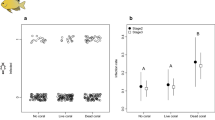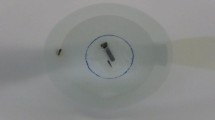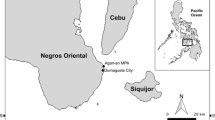Abstract
The ecological role of parasites in the early life-history stages of coral reef fish, and whether this varies between fish with and without a pelagic phase, was investigated. The susceptibility to, and effect of reef-based micropredatory gnathiid isopods on larval, recently settled, and juvenile fishes was tested using two damselfishes (Pomacentridae): Neopomacentrus azysron, which has pelagic larvae, and Acanthochromis polyacanthus, which does not. When larval and recently settled stages of N. azysron and very young A. polyacanthus juveniles (smaller than larval N. azysron) were exposed to one or three gnathiids, the proportion of infections did not vary significantly among the three host types or between the number of gnathiids to which the fish were exposed. The overall infection was 35%. Mortality, however, differed among the three gnathiid-exposed host types with most deaths occurring in larval N. azysron; no mortalities occurred for recently settled N. azysron exposed to one or three gnathiids, and A. polyacanthus exposed to one gnathiid. Mortality did not differ significantly between larval N. azysron and A. polyacanthus juveniles, failing to provide support for the hypothesis that reef-based A. polyacanthus juveniles are better adapted to gnathiid attack than fish with a pelagic phase. The study suggests that settling on the reef exposes young fish to potentially deadly micropredators. This supports the idea that the pelagic phase may allow young fish to avoid reef-based parasites.


Similar content being viewed by others
References
Adlard RD, Lester RJG (1994) Dynamics of the interaction between the parasitic isopod, Anilocra pomacentri, and the coral reef fish, Chromis nitida. Parasitology 109:311–324
Allen GR (1975) Damselfishes of the South Seas. T.F.H. Publications, London
Bailey KM, Houde ED (1989) Predation on eggs and larvae of marine fishes and the recruitment problem. Adv Mar Biol 26:1–83
Barber I, Hoare D, Krause J (2000) Effects of parasites on fish behaviour: a review and evolutionary perspective. Rev Fish Biol Fish 10:131–165
Bergenius MAJ, Meekan MG, Ross Robertson D, McCormick MI (2002) Larval growth predicts the recruitment success of a coral reef fish. Oecologia 131:521–525
Booth DJ (1991) The effect of sampling frequency on estimates of recruitment of the domino damselfish Dascyllus albisella Gill. J Exp Mar Biol Ecol 145:149–159
Chambers SD, Sikkel PC (2002) Diel emergence patterns of ecologically important, fish-parasitic, gnathiid isopod larvae on Caribbean coral reefs. Caribb J Sci 38:37–43
Clobert J, Danchin E, Dhondt AA, Nichols JD (2001) Dispersal. Oxford University Press, Oxford
Combes C (2001) Parasitism: the ecology and evolution of intimate interactions. University of Chicago Press, Chicago
Cribb TH, Pichelin S, Dufour V, Bray RA, Chauvet C, Faliex E, Galzin R, Lo-Yat A, Morand S, Rigby MC, Sasal P (2000) Parasites of recruiting coral reef fish larvae in New Caledonia. Int J Parasitol 30:1445–1451
Danilowicz BS, Sale PF (1999) Relative intensity of predation on the French grunt, Haemulon flavolineatum, during diurnal, dusk, and nocturnal periods on a coral reef. Mar Biol 133:337–343
Davies AJ, Smit NJ, Hayes PM, Seddon AM, Wertheim D (2004) Haemogregarina bigemia (Protozoa: Apicomplexa: Adeleorina) – past, present, and future. Folia Parasitol 51:99–108
Dufour V, Galzin R (1993) Colonization patterns of reef fish larvae to the lagoon at Moorea Island, French Polynesia. Mar Ecol Prog Ser 102:143–152
Grutter AS (1994) Spatial and temporal variations of the ectoparasites of seven coral reef fish from Lizard Island and Heron Island, Australia. Mar Ecol Prog Ser 115:21–30
Grutter AS (1999) Infestation dynamics of parasitic gnathiid isopod juveniles on a coral reef fish Hemigymnus melapterus. Mar Biol 135:545–552
Grutter AS (2001) Parasite infection rather than tactile stimulation is the proximate cause of cleaning behaviour in reef fish. Proc R Soc Lond B Biol Sci 268:1361–1365
Grutter AS (2003) Feeding ecology of a parasitic gnathiid isopod. Mar Ecol Prog Ser 259:295–302
Grutter AS, Heindrikz J (1999) Diurnal variation in the abundance of parasitic gnathiid isopod juveniles on coral reef fish: its implications for cleaning interactions. Coral Reefs 18:187–191
Grutter AS, Poulin R (1998) Intraspecific and interspecific relationships between host size and the abundance of parasitic larval gnathiid isopods on coral reef fish. Mar Ecol Prog Ser 164:263–271
Grutter AS, Morgan J, Adlard R (2000) Characterising parasitic gnathiid isopod species and matching life stages using ribosomal DNA ITS2 sequences. Mar Biol 36:201–205
Holbrook SJ, Schmitt RJ (1997) Settlement patterns and process in a coral reef damselfish: in situ nocturnal observations using infrared video. Proc 8th Int Coral Reef Symp 2:1143–1148
Jones C, Grutter AS (2005) Cultured parasitic isopods (Gnathia sp.) reduce haematocrit in captive Hemigymnus melapterus (Bloch) (Pisces: Labridae) on the Great Barrier Reef. J Fish Biol 66:860–864
Jones CM, Grutter AS (2007) Variation in emergence of parasitic and predatory isopods among habitats at Lizard Island, Great Barrier Reef. Mar Biol 150:919–927
Kavanagh K (2000) Larval brooding in the marine damselfish Acanthochromis polyacanthus (Pomacentridae) is correlated with highly divergent morphology, ontogeny and life-history traits. Bull Mar Sci 66:321–337
Lafferty KD (1999) The evolution of trophic transmission. Parasitol Today 15:111–115
Lafferty KD, Kuris AM (2002) Trophic strategies, animal diversity and body size. Trends Ecol Evol 17:507–513
Leis JM, Carson-Ewart BM (1997) In situ swimming speeds of the late pelagic larvae of some Indo-Pacific coral-reef fishes. Mar Ecol Prog Ser 159:165–174
Leis JM, McCormick MI (2002) The biology, behavior, and ecology of the pelagic, larval stage of coral reef fishes. In: Sale PF (ed) Coral reef fishes – dynamics and diversity in a complex ecosystem. Academic Press, London, pp 171–199
McCormick MI, Hoey AS (2004) Larval growth history determines juvenile growth and survival in a tropical marine fish. Oikos 106:225–242
Meekan MG, Wilson SG, Halford A, Retzel A (2001) A comparison of catches of fishes and invertebrates by two light trap designs, in tropical NW Australia. Mar Biol 139:373–381
Monod T (1926) Les Gnathiidae. Essai monographique (morphologie, biologie, systematique). Mémoires de la Société des Sciences Naturelles du Maroc 13:1–668
Nakazono A (1993) One-parental removal experiment in the brood-caring damselfish Acanthochromis polyacanthus, with preliminary data on reproductive biology. Aust J Mar Freshw Res 44:699–707
Paperna I, Por FD (1977) Preliminary data on the Gnathiidae (Isopoda) of the Northern Red Sea, the Bitter Lakes, and the Mediterranean and the biology of Gnathia piscivora n sp. Rapports de la Commission Internationale pour la Mer Méditerranée 24:195–197
Penfold R, Grutter AS, Kuris AM, McCormick MI, Jones CM (in press) Interactions between Acanthachromis polyacanthus and gnathiid isopods – Predation or Parasitism? Mar Ecol Prog Ser. doi:10.3354/meps07312 [prepress abstract only]
R Development Core Team (2006) R: A language and environment for statistical computing. R Foundation for Statistical Computing, Vienna, Austria. http://www.R-project.org
Randall DJ, Allen GR, Steene RC (1997) Fishes of the Great Barrier Reef and Coral Sea. Crawford House Publishing, Bathurst
Rigby MC, Dufour V (1996) Parasites of coral reef fish recruits, Epinephelus merra (Serranidae), in French Polynesia. J Parasitol 82:405–408
Robertson DR (1973) Field observations on the reproductive behaviour of a pomacentrid fish Acanthochromis polyacanthus. Z Tierpsychol 32:319–324
Sasal P (2003) Experimental test of the influence of the size of shoals and the density of fish on parasite infections. Coral Reefs 22:241–246
Searcy SP, Sponaugle S (2000) Variable larval growth in a coral reef fish. Mar Ecol Prog Ser 206:213–226
Sikkel PC, Cheney KL, Côté IM (2004) In situ evidence for ectoparasites as a proximate cause of cleaning interactions in reef fish. Anim Behav 68:241–247
Sikkel PC, Schaumburg CS, Mathenia JK (2006) Diel infestation dynamics of gnathiid isopod larvae parasitic on Caribbean reef fish. Coral Reefs 25:683–689
Smit NJ, Davies AJ (2004) The curious life-style of the parasitic stages of gnathiid isopods. Adv Parasitol 58:289–391
Strathmann RR, Hughes TP, Kuris AM, Lindeman KC, Morgan SG, Pandolfi JM, Warner RR (2002) Evolution of local recruitment and its consequences for marine populations. Bull Mar Sci 70:S377–S396
Thresher RE (1985) Distribution, abundance, and reproductive success in the coral-reef fish Acanthochromis polyacanthus. Ecology 66:1139–1150
Wilson DT, McCormick MI (1999) Microstructure of settlement-marks in the otoliths of tropical reef fishes. Mar Biol 134:29–41
Acknowledgments
We thank L. Curtis, C.M. Jones, J.G. Rumney, S. Walker and the Lizard Island Research Station Staff for their assistance in the field; and C.M. Jones, G. Munoz and J. Nicholls for comments on the article. An Australian Research Council Discovery Grant funded this study.
Author information
Authors and Affiliations
Corresponding author
Additional information
Communicated by: Biology Editor Dr Michael Lessus.
Rights and permissions
About this article
Cite this article
Grutter, A.S., Pickering, J.L., McCallum, H. et al. Impact of micropredatory gnathiid isopods on young coral reef fishes. Coral Reefs 27, 655–661 (2008). https://doi.org/10.1007/s00338-008-0377-4
Received:
Revised:
Accepted:
Published:
Issue Date:
DOI: https://doi.org/10.1007/s00338-008-0377-4




